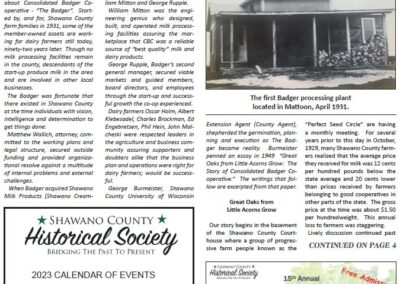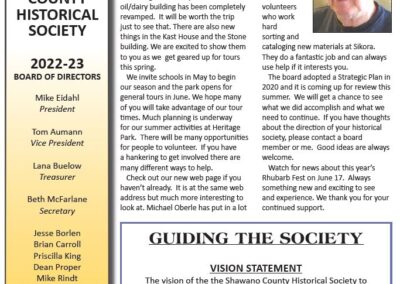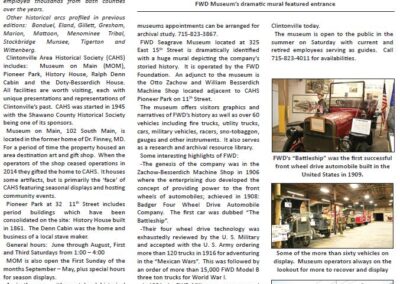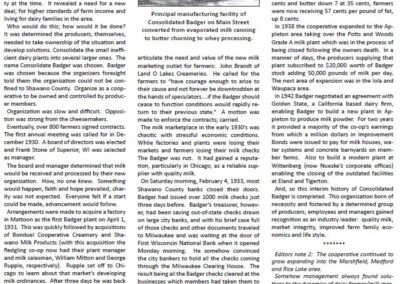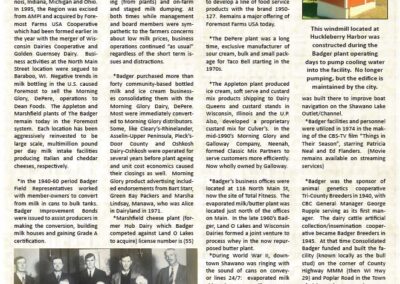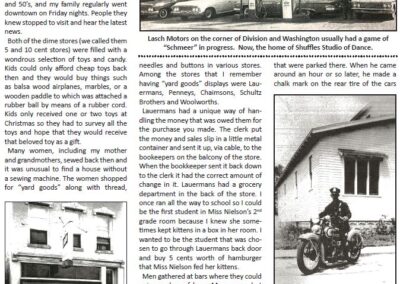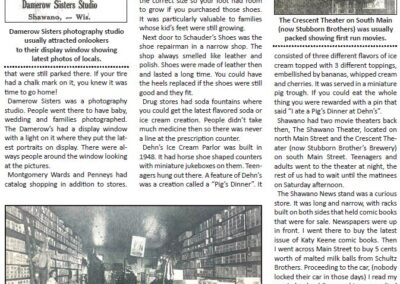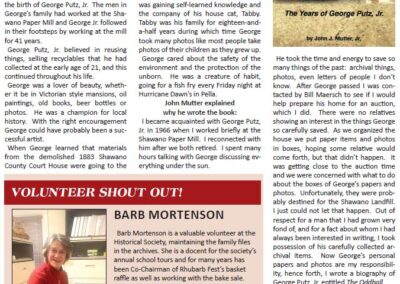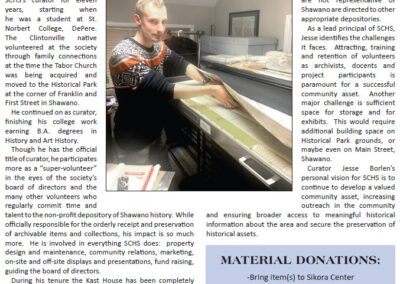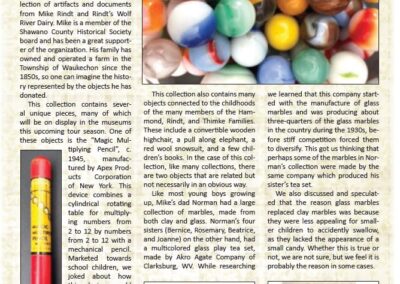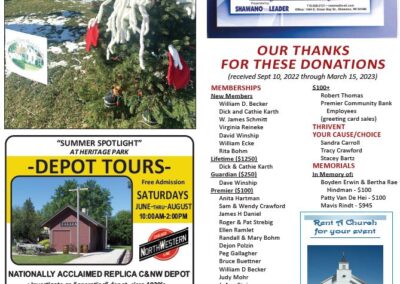Pages
Online Edition
Preservation Press Spring 2023
Dairy Farmers Working to Improve Their Lot
Editors note: In the fall issue of Preservation Press the article “The Chamber Did It” teased this article about Consolidated Badger Cooperative – “The Badger.” Started by, and for, Shawano County farm families in 1931, some of the member-owned assets are working for dairy farmers still today, ninety-two years later. Though no milk processing facilities remain in the county, descendants of the start-up produce milk in the area and are involved in other local businesses.
The Badger was fortunate that there existed in Shawano County at the time individuals with vision, intelligence and determination to get things done:
Matthew Wallich, attorney, committed to the working plans and legal structure, secured outside funding and provided organizational resolve against a multitude of internal problems and external challenges.
When Badger acquired Shawano Milk Products (Shawano Creamery Co.) in 1931 it could be said it also cemented Its future success, as with the acquisition came William Mitton and George Rupple.
William Mitton was the engineering genius who designed, built, and operated milk processing facilities assuring the marketplace that CBC was a reliable source of “best quality” milk and dairy products.
George Rupple, Badger’s second general manager, secured viable markets and guided members, board directors, and employees through the start-up and successful growth the co-op experienced.
Dairy farmers Oscar Holm, Albert Klebesadel, Charles Brockman, Ed Engebretsen, Phil Hein, John Malcheski were respected leaders in the agriculture and business community assuring supporters and doubters alike that the business plan and operations were right for dairy farmers; would be successful.
George Burmeister, Shawano County University of Wisconsin
Extension Agent (County Agent), shepherded the germination, planning and execution as The Badger became reality. Burmeister penned an essay in 1949 “Great Oaks from Little Acorns Grow: The Story of Consolidated Badger Cooperative.” The writings that follow are excerpted from that paper.
*****************
Great Oaks from
Little Acorns Grow
Our story begins in the basement of the Shawano County Courthouse where a group of progressive farm people known as the “Perfect Seed Circle” are having a monthly meeting. For several years prior to this day in October, 1929, many Shawano County farmers realized that the average price they received for milk was 12 cents per hundred pounds below the state average and 20 cents lower than prices received by farmers belonging to good cooperatives in other parts of the state. The gross price at the time was about $1.50 per hundredweight. This annual loss to farmers was staggering.
Lively discussion continued past midnight and all phases of the milk industry were hashed and rehashed. Mike Wallrich, a member of the seed circle and lumberman, farmer and lawyer, made a motion to appoint a committee to study the problems.
The University of Wisconsin College of Agriculture agreed to conduct a survey in the area of the dairy situation. This survey revealed an immediate need for a more diversified milk handling system – there were about 100 “corner” independent cheese factories in the county at the time. It revealed a need for a new deal; for higher standards of farm income and living for dairy families in the area.
Who would do this; how would it be done? It was determined the producers, themselves, needed to take ownership of the situation and develop solutions. Consolidate the small inefficient dairy plants into several larger ones. The name Consolidate Badger was chosen. Badger was chosen because the organizers foresight told them the organization could not be confined to Shawano County. Organize as a cooperative to be owned and controlled by producer members.
Organization was slow and difficult. Opposition was strong from the cheesemakers.
Eventually, over 800 farmers signed contracts. The first annual meeting was called for in December 1930. A board of directors was elected and Frank Stone of Superior, WI was selected as manager.
The board and manager determined that milk would be received and processed by their new organization. How, no one knew. Something would happen, faith and hope prevailed, charity was not expected. Everyone felt if a start could be made, advancement would follow.
Arrangements were made to acquire a factory in Mattoon as the first Badger plant on April 1, 1931. This was quickly followed by acquisitions of Bonduel Cooperative Creamery and Shawano Milk Products (with this acquisition the fledgling co-op now had their plant manager and milk salesman, William Mitton and George Rupple, respectively). Rupple set off to Chicago to learn about that market’s developing milk ordinances. After three days he was back in Shawano County enthusiastically selling the idea of “Grade A” milk to Badger leaders and member-owners.
Results were forthcoming: the Eland, Tigerton and Town Line cheese factories joined the Badger. With the independent factories losing business, they started fighting back with propaganda and actually raising their payments to producers. They went so far as to convince some Badger contractees to petition for a meeting for the purpose of negating the contracts. Enter another person with the ability to articulate the need and value of the new milk marketing outlet for farmers: John Brandt of Land O Lakes Creameries. He called for the farmers to “have courage enough to arise to their cause and not forever be downtrodden at the hands of speculators….if the Badger should cease to function conditions would rapidly return to their previous state.” A motion was made to enforce the contracts; carried.
The milk marketplace in the early 1930’s was chaotic with stressful economic conditions. While factories and plants were losing their markets and farmers losing their milk checks The Badger was not. It had gained a reputa¬tion, particularly in Chicago, as a reliable supplier with quality milk.
On Saturday morning, February 4, 1933, most Shawano County banks closed their doors. Badger had issued over 1000 milk checks just three days before. Badger’s treasurer, however, had been saving out-of-state checks drawn on large city banks, and with his brief case full of those checks and other documents traveled to Milwaukee and was waiting at the door of First Wisconsin National Bank when it opened Monday morning. He somehow convinced the city bankers to hold all the checks coming through the Milwaukee Clearing House. The result being all the Badger checks cleared at the businesses which members had taken them to be cashed: grocery stores, feed mills, etc. In fact, many local businesses were made into check cashing exchanges with cash expressed to them from Badger’s major customers in Milwaukee and Chicago.
Never again did anyone dare question the ability of Badger to meet obligations. While many other milk plants and cheese factories paid for milk with script, Badger members received cash.
In January 1936 General Manager Stone resigned to take a position with Land O Lakes. The board quickly selected George Rupple to succeed him. He immediately initiated a new membership campaign, understanding that growth was necessary and opportunities for growth in the marketplace existed.
A review of what Badger by this time had achieved for producers was shown in 1936.
In 1929 on a 19.5 cent cheese market and 42 cent butter market Shawano County factories paid 49 cents per pound of butterfat to producers. In 1936, with cheese down 2 cents to 17.5 cents and butter down 7 at 35 cents, farmers were now receiving 57 cents per pound of fat, up 8 cents.
In 1938 the cooperative expanded to the Appleton area taking over the Potts and Woods Grade A milk plant which was in the process of being closed following the owners death. In a manner of days, the producers supplying that plant subscribed to $20,000 worth of Badger stock adding 50,000 pounds of milk per day. The next area of expansion was in the Iola and Waupaca area.
In 1942 Badger negotiated an agreement with Golden State, a California based dairy firm, enabling Badger to build a new plant in Ap¬pleton to produce milk powder. For two years it provided a majority of the co-op’s earnings from which a million dollars in Improvement Bonds were issued to pay for milk houses, water systems and concrete barnyards on member farms. Also to build a modern plant at Wittenberg (now Nueske’s corporate offices) enabling the closing of the outdated facilities at Eland and Tigerton.
And, so this interim history of Consolidated Badger is completed. This organization born of necessity and fostered by a determined group of producers, employees and managers gained recognition as an industry leader: quality milk, market integrity, improved farm family economics and life style.
Editors note 2: The cooperative continued to grow expanding into the Marshfield, Medford and Rice Lake area.
Somehow management always found solu¬tions to the dynamics of dairy farmer/milk marketing competitiveness overcoming resistance to change and old loyalties to local plants, plant field representatives and milk haulers. Badger was at one time recognized as the largest farmer-owned milk processing/marketing business in Wisconsin. The state and national dairy industry looked to Badger personnel for leadership in such organizations as: National Milk Producers Federation, Wisconsin Dairy Products Association, Wisconsin Federation of Cooperatives, Wisconsin Dairy Council, American Butter Institute, Farm Credit Bank
*****************
PRESIDENT’S MESSAGE
MIKE EIDAHL
“April showers bring May flowers.” Not actually sure who said that, but we do like to see the new growth of plants and flowers in the spring. It seems to brighten our days. There will be some new exciting things appearing at Heritage Park this year also. The oil/dairy building has been completely revamped. It will be worth the trip just to see that. There are also new things in the Kast House and the Stone building. We are excited to show them to you as we get geared up for tours this spring.
We invite schools in May to begin our season and the park opens for general tours in June. We hope many of you will take advantage of our tour times. Much planning is underway for our summer activities at Heritage Park. There will be many opportunities for people to volunteer. If you have a hankering to get involved there are many different ways to help.
Check out our new web page if you haven’t already. It is at the same web address but much more interesting to look at. Michael Oberle has put in a lot of time on this and it looks great.
I want to take this time to thank our faithful volunteers who work hard sorting and cataloging new materials at Sikora. They do a fantastic job and can always use help if it interests you.
The board adopted a Strategic Plan in 2020 and it is coming up for review this summer. We will get a chance to see what we did accomplish and what we need to continue. If you have thoughts about the direction of your historical society, please contact a board member or me. Good ideas are always welcome.
Watch for news about this year’s Rhubarb Fest on June 17. Always something new and exciting to see and experience. We thank you for your continued support.
*****************
Clintonville History Preserved
This is the last in series of articles in Preservation Press highlighting the historical assets of the greater Shawano County area. While Clintonville is located in Waupaca County its proximity begets shared historical elements: the rivers, early lumbering years and Four Wheel Drive – “The Drive” – which employed thousands from both counties over the years.
Other historical arcs profiled in previous editions: Bonduel, Eland, Gillett, Gresham, Marion, Mattoon, Menominee Tribal, Stockbridge Munsee, Tigerton and Wittenberg.
Clintonville Area Historical Society (CAHS) includes: Museum on Main (MOM), Pioneer Park, History House, Ralph Denn Cabin and the Doty-Besserdich House. All facilities are worth visiting, each with unique presentations and representations of Clintonville’s past. CAHS was started in 1945 with the Shawano County Historical Society being one of its sponsors.
Museum on Main, 102 South Main, is located in the former home of Dr. Finney, MD. For a period of time the property housed an area destination art and gift shop. When the operators of the shop ceased operations in 2014 they gifted the home to CAHS. It houses some artifacts, but is primarily the ‘face’ of CAHS featuring seasonal displays and hosting community events.
Pioneer Park at 32 11th Street includes period buildings which have been consolidated on the site: History House built in 1861. The Denn Cabin was the home and business of a local stave maker.
General hours: June through August, First and Third Saturdays from 1:00 – 4:00
MOM is also open the First Sunday of the months September – May, plus special hours for season displays.
As is the case with most local historical museums appointments can be arranged for archival study. 715-823-3867.
FWD Seagrave Museum located at 325 East 15th Street is dramatically identified with a huge mural depicting the company’s storied history. It is operated by the FWD Foundation. An adjunct to the museum is the Otto Zachow and William Besserdich Machine Shop located adjacent to CAHS Pioneer Park on 11th Street.
The museum offers visitors graphics and narratives of FWD’s history as well as over 60 vehicles including fire trucks, utility trucks, cars, military vehicles, racers, sno-tobaggon, gauges and other instruments. It also serves as a research and archival resource library.
Some interesting highlights of FWD:
The genesis of the company was in the Zachow-Besserdich Machine Shop in 1906 where the enterprising duo developed the concept of providing power to the front wheels of automobiles; achieved in 1908: Badger Four Wheel Drive Automobile Company. The first car was dubbed “The Battleship”.
Their four wheel drive technology was exhaustedly reviewed by the U. S. Military and accepted with the U. S. Army ordering more than 120 trucks in 1916 for adventuring in the “Mexican Wars”. This was followed by an order of more than 15,000 FWD Model B three ton trucks for World War I.
In 1931, the FWD-Miller race car competed in the Indianapolis 500.
FWD formed a Flight Department in 1939 which lead to the start-up of Wisconsin Central Airlines in 1944, then North Central Airlines which transported passengers from Wisconsin airports to Chicago and beyond for years. The current successor is Delta Airlines.
In 1963, FWD acquired Seagrave Fire Apparatus of Columbus, Ohio. The operating headquarters of the company is domiciled in Clintonville today.
The museum is open to the public in the summer on Saturday with current and retired employees serving as guides. Call 715-823-4011 for availabilities.
*****************
The Badger Story
*The cooperative operated under the name Consolidated Badger Cooperative from 1931-1985. Then adopted the Morning Glory Farms name to take advantage of its brand image. Following a merger in 1986 with Associated Milk Producers (AMPI), San Antonio, TX local operations were known as the Morning Glory Farms Region of AMPI, now including member-owners in Illinois, Indiana, Michigan and Ohio. In 1995, the Region was excised from AMPI and acquired by Foremost Farms USA Cooperative which had been formed earlier in the year with the merger of Wisconsin Dairies Cooperative and Golden Guernsey Dairy. Business activities at the North Main Street location were segued to Baraboo, WI. Negative trends in milk bottling in the U.S. caused Foremost to sell the Morning Glory, DePere, operations to Dean Foods. The Appleton and Marshfield plants of The Badger remain today in the Foremost system. Each location has been aggressively reinvested to be large scale, multimillion pound per day milk intake facilities producing Italian and cheddar cheeses, respectively.
*In the 1940-60 period Badger Field Representatives worked with member-owners to convert from milk in cans to bulk tanks. Badger Improvement Bonds were issued to assist producers in making the conversion, building milk houses and gaining Grade A certification.
*The cooperative dealt with two significant national events: Milk Strikes of 1933 sponsored by the Wisconsin Cooperative Milk Pool in conjunction with the National Farm Holiday Association. A riot broke out at Badger’s Bonduel location necessitating the call up of the Wisconsin National Guard. In the 1960s the National Farmers Organization (NFO) called for milk withholding (from plants) and on-farm and staged milk dumping. At both times while management and board members were sympathetic to the farmers concerns about low milk prices, business operations continued “as usual” regardless of the short term issues and distractions.
*Badger purchased more than forty community-based bottled milk and ice cream businesses consolidating them with the Morning Glory Dairy, DePere. Most were immediately converted to Morning Glory distributors. Some, like Cleary’s-Rhinelander, Asselin-Upper Peninsula, Pleck’s- Door County and Oshkosh Dairy-Oshkosh were operated for several years before plant ageing and unit cost economics caused their closings as well. Morning Glory product advertising included endorsements from Bart Starr, Green Bay Packers and Marsha Lindsay, Manawa, who was Alice in Dairyland in 1971.
*Marshfield cheese plant (former Hub Dairy which Badger competed against Land O Lakes to acquire) license number is (55) 1950-127. High volumes of white cheddar cheese made there in 40 pound blocks were purchased by pizzerias in northeast U.S. Many of these restaurants were operated by Greek immigrants who did not read English so they would order the white cheddar (preferred by them over mozzarella) by the number on the box: 1950-127. This led the cooperative’s marketing personnel to develop a line of food service products with the brand 1950- 127. Remains a major offering of Foremost Farms USA today.
*The DePere plant was a long time, exclusive manufacturer of sour cream, bulk and small package for Taco Bell starting in the 1970s.
*The Appleton plant produced ice cream, soft serve and custard mix products shipping to Dairy Queens and custard stands in Wisconsin, Illinois and the U.P. Also, developed a proprietary custard mix for Culver’s. In the mid-1990’s Morning Glory and Galloway Company, Neenah, formed Classic Mix Partners to serve customers more efficiently. Now wholly owned by Galloway.
*Badger’s business offices were located at 116 North Main St, now the site of Total Fitness. The evaporated milk/butter plant was located just north of the offices on Main. In the late 1960’s Badger, Land O Lakes and Wisconsin Dairies formed a joint venture to process whey in the now repurposed butter plant.
*During World War II, downtown Shawano was ringing with the sound of cans on conveyor lines 24/7: evaporated milk shipped to U.S. military posts around the world and “Cow Ghee,” a mixture of butter, cheese curd and skim milk powder known as “chewing butter” for the fighting forces.
*The Badger maintenance shop on Fifth Street was a community resource by default as it had equipment that could bend, shape, weld metals. The Shawano Lake Boat Club’s weed blaster was built there to improve boat navigation on the Shawano Lake Outlet/Channel.
*Badger facilities and personnel were utilized in 1974 in the making of the CBS-TV film “Things in Their Season”, starring Patricia Neal and Ed Flanders. (Movie remains available on streaming services)
*Badger was the sponsor of animal genetics cooperative Tri-County Breeders in 1940, with CBC General Manager George Rupple serving as its first manager. The dairy cattle artificial collection/insemination cooperative became Badger Breeders in 1945. At that time Consolidated Badger funded and built the facility (known locally as the bull stud) on the corner of County Highway MMM (then WI Hwy 29) and Poplar Road in the Town of Richmond. In 1966 the name was changed to Midwest Breeders. Now known as PEAK, a subsidiary of URUS, an international livestock development holding company.
*Consolidated Badger-Morning Glory General Managers; Frank Stone 1931-35, George Rupple 1936-69, Neil McBeath 1970-74, Archie Smith 1975-84, Jim Kasten 1985-95.
*****************
Friday Nights Downtown
By Elaine Knope
Shawano’s Main Street was a busy place on Friday nights in the 1940’s and 50’s. That was the only night stores stayed open until 9PM. Many people did their socializing and shopping on Friday nights.
I was a kid then, growing up in the 40’s and 50’s, and my family regularly went downtown on Friday nights. People they knew stopped to visit and hear the latest news.
Both of the dime stores (we called them 5 and 10 cent stores) were filled with a wondrous selection of toys and candy. Kids could only afford cheap toys back then and they would buy things such as balsa wood airplanes, marbles, or a wooden paddle to which was attached a rubber ball by means of a rubber cord. Kids only received one or two toys at Christmas so they had to survey all the toys and hope that they would receive that beloved toy as a gift.
Many women, including my mother and grandmothers, sewed back then and it was unusual to find a house without a sewing machine. The women shopped for “yard goods” along with thread, needles and buttons in various stores. Among the stores that I remember having “yard goods” displays were Lauermans, Penneys, Chaimsons, Schultz Brothers and Woolworths.
Lauermans had a unique way of handling the money that was owed them for the purchase you made. The clerk put the money and sales slip in a little metal container and sent it up, via cable, to the bookeepers on the balcony of the store. When the bookkeeper sent it back down to the clerk it had the correct amount of change in it. Lauermans had a grocery department in the back of the store. I once ran all the way to school so I could be the first student in Miss Nielson’s 2nd grade room because I knew she sometimes kept kittens in a box in her room. I wanted to be the student that was chosen to go through Lauermans back door and buy 5 cents worth of hamburger that Miss Nielson fed her kittens.
Men gathered at bars where they could enjoy a glass of beer. Many men shot pool or played cards too. A card game called “Smear” was always going on in Lasch’s Garage on the corner of Division and Washington Streets.
Police officer Louie Weigel, on his trusty motorcycle, kept “law and order” on Friday nights. He carried a stick like affair with a piece of chalk fastened to the end. Weigel rode down Main Street, paying particular attention to the cars that were parked there. When he came around an hour or so later, he made a chalk mark on the rear tire of the cars that were still parked there. If your tire had a chalk mark on it, you knew it was time to go home!
Damerow Sisters was a photography studio. People went there to have baby, wedding and families photographed. The Damerow’s had a display window with a light on it where they put the latest portraits on display. There were always people around the window looking at the pictures.
Montgomery Wards and Penneys had catalog shopping in addition to stores. You ordered what they didn’t carry in their stores and it was shipped to the store and you picked it up. It was a great day when their Christmas catalogs came in the mail to your house because you could wish for a certain toy for your Christmas gift!
Schauder’s and Reinholz’s were shoe stores that had X-ray machines. You stuck your foot in the machine encased in the shoe you were contemplating buying. The X-ray machine told whether it was the correct size so your foot had room to grow if you purchased those shoes. It was particularly valuable to families whose kid’s feet were still growing.
Next door to Schauder’s Shoes was the shoe repairman in a narrow shop. The shop always smelled like leather and polish. Shoes were made of leather then and lasted a long time. You could have the heels replaced if the shoes were still good and they fit.
Drug stores had soda fountains where you could get the latest flavored soda or ice cream creation. People didn’t take much medicine then so there was never a line at the prescription counter.
Dehn’s Ice Cream Parlor was built in 1948. It had horse shoe shaped counters with miniature jukeboxes on them. Teenagers hung out there. A feature of Dehn’s was a creation called a “Pig’s Dinner.” It consisted of three different flavors of ice cream topped with 3 different toppings, embellished by bananas, whipped cream and cherries. It was served in a miniature pig trough. If you could eat the whole thing you were rewarded with a pin that said “I ate a Pig’s Dinner at Dehn’s.”
Shawano had two movie theaters back then, The Shawano Theater, located on north Main Street and the Crescent Theater (now Stubborn Brother’s Brewery) on south Main Street. Teenagers and adults went to the theater at night, the rest of us had to wait until the matinees on Saturday afternoon.
The Shawano News stand was a curious store. It was long and narrow, with racks built on both sides that held comic books that were for sale. Newspapers were up in front. I went there to buy the latest issue of Katy Keene comic books. Then I went across Main Street to buy 5 cents worth of malted milk balls from Schultz Brothers. Proceeding to the car, (nobody locked their car in those days) I read my comic book while munching on malted milk balls.
Slowly, as “big box” stores arrived on east Green Bay Street business on Main Street diminished. The “big box” stores were open every night of the week. Stores on Main Street closed because they couldn’t compete with K-Mart and Walmart.
*****************
Old Character: New Book
SCHS member and volunteer John J. Mutter, Jr. has written a new book The Oddball about one of our community’s most interesting characters, George Putz, Jr. who passed away in 2006 at the age of 82.
John provided the following synopsis:
The Oddball begins with George’s grandfather Julius, and works toward the birth of George Putz, Jr. The men in George’s family had worked at the Shawano Paper Mill and George Jr. followed in their footsteps by working at the mill for 41 years.
George Putz, Jr. believed in reusing things, selling recyclables that he had collected at the early age of 21, and this continued throughout his life.
George was a lover of beauty, whether it be in Victorian style mansions, oil paintings, old books, beer bottles or photos. He was a champion for local history. With the right encouragement George could have probably been a successful artist.
When George learned that materials from the demolished 1883 Shawano County Court House were going to the dump, he bargained for the hauling of 133 dump truck loads of rubble to his property on the Wolf River, just north of County Highway M. People who knew him began to wonder if George had lost it! He was setting a standard for his entire life, reuse – don’t waste!
George never married and his only attachment in life besides the paper mill was gaining self-learned knowledge and the company of his house cat, Tabby. Tabby was his family for eighteen-and-a-half years during which time George took many photos like most people take photos of their children as they grew up.
George cared about the safety of the environment and the protection of the unborn. He was a creature of habit, going for a fish fry every Friday night at Hurricane Dawn’s in Pella.
John Mutter explained why he wrote the book:
I became acquainted with George Putz, Jr. in 1966 when I worked briefly at the Shawano Paper Mill. I reconnected with him after we both retired. I spent many hours talking with George discussing everything under the sun.
He took the time and energy to save so many things of the past: archival things, photos, even letters of people I don’t know. After George passed I was contacted by Bill Maersch to see if I would help prepare his home for an auction, which I did. There were no relatives showing an interest in the things George so carefully saved. As we organized the house we put paper items and photos in boxes, hoping some relative would come forth, but that didn’t happen. It was getting close to the auction time and we were concerned with what to do about the boxes of George’s papers and photos. Unfortunately, they were probably destined for the Shawano Landfill. I just could not let that happen. Out of respect for a man that I had grown very fond of, and for a fact about whom I had always been interested in writing, I took possession of his carefully collected archival items. Now George’s personal papers and photos are my responsibility, hence forth, I wrote a biography of George Putz, Jr. entitled The Oddball.
The book is available at SCHS’s gift shop in the Sikora Archives and Reception Center, 524 North Franklin Street, Shawano. Hours are Monday and Thursday 10:00 am to 3:00 pm.
In addition to the availability of The Oddball, the shop offers Mutters’ previously published books and those of other local writers. Also, post cards, picture calendars, reproduced historical posters, cookbooks and more.
*****************
Our Curator; Leader
Curator, as defined by Webster: The administrative director of a museum, library, or similar institution — to take care of.
Curator, as defined by Shawano County Historical Society’s own Jesse Borlen: do whatever needs to be done to assure that the community has access to its history.
Jesse Borlen has been SCHS’s curator for eleven years, starting when he was a student at St. Norbert College, DePere. The Clintonville native volunteered at the society through family connections at the time the Tabor Church was being acquired and moved to the Historical Park at the corner of Franklin and First Street in Shawano.
He continued on as curator, finishing his college work earning B.A. degrees in History and Art History.
Though he has the official title of curator, he participates more as a “super-volunteer” in the eyes of the society’s board of directors and the many other volunteers who regularly commit time and talent to the non-profit depository of Shawano history. While officially responsible for the orderly receipt and preservation of archivable items and collections, his impact is so much more. He is involved in everything SCHS does: property design and maintenance, community relations, marketing, on-site and off-site displays and presentations, fund raising, guiding the board of directors.
During his tenure the Kast House has been completely restored/refurbished. The Stone Building has been turned into a walk-through exhibit of Shawano and Menominee County businesses and industries of earlier years. Currently, the Dairy Building is being reset with more “hands-on” exhibits.
Jesse’s training and experience are exercised almost daily as the final authority on evaluating material contributions from individuals, families, business and community organizations. In this pursuit, his guiding criteria include being important to Shawano County history and not duplicative of existing holdings. Items offered which are not representative of Shawano are directed to other appropriate depositories.
As a lead principal of SCHS, Jesse identifies the challenges it faces. Attracting, training and retention of volunteers as archivists, docents and project participants is paramount for a successful community asset. Another major challenge is sufficient space for storage and for exhibits. This would require additional building space on Historical Park grounds, or maybe even on Main Street, Shawano.
Curator Jesse Borlen’s personal vision for SCHS is to continue to develop a valued community asset, increasing outreach in the community and ensuring broader access to meaningful historical information about the area and secure the preservation of historical assets.
*****************
From the Archives
Jesse Borlen, Curator
Throughout the year many of our volunteers are working on cataloguing collections. Gini Reineke is currently working on a large collection of artifacts and documents from Mike Rindt and Rindt’s Wolf River Dairy. Mike is a member of the Shawano County Historical Society board and has been a great supporter of the organization. His family has owned and operated a farm in the Township of Waukechon since the 1850s, so one can imagine the history represented by the objects he has donated.
This collection contains several unique pieces, many of which will be on display in the museums this upcoming tour season. One of these objects is the “Magic Multiplying Pencil”, c. 1945, manufactured by Apex Products Corporation of New York. This device combines a cylindrical rotating table for multiplying numbers from 2 to 12 by numbers from 2 to 12 with a mechanical pencil. Marketed towards school children, we joked about how this device would never be allowed in schools today. While researching this object, Gini discovered that a matching item is in the collections of the Smithsonian National Museum of American History.
This collection also contains many objects connected to the childhoods of the many members of the Hammond, Rindt, and Thimke Families. These include a convertible wooden highchair, a pull along elephant, a red wool snowsuit, and a few children’s books. In the case of this collection, like many collections, there are two objects that are related but not necessarily in an obvious way.
Like most young boys growing up, Mike’s dad Norman had a large collection of marbles, made from both clay and glass. Norman’s four sisters (Bernice, Rosemary, Beatrice, and Joanne) on the other hand, had a multicolored glass play tea set, made by Akro Agate Company of Clarksburg, WV. While researching we learned that this company started with the manufacture of glass marbles and was producing about three-quarters of the glass marbles in the country during the 1930s, before stiff competition forced them to diversify. This got us thinking that perhaps some of the marbles in Norman’s collection were made by the same company which produced his sister’s tea set.
We also discussed and speculated that the reason glass marbles replaced clay marbles was because they were less appealing for smaller children to accidently swallow, as they lacked the appearance of a small candy. Whether this is true or not, we are not sure, but we feel it is probably the reason in some cases.

